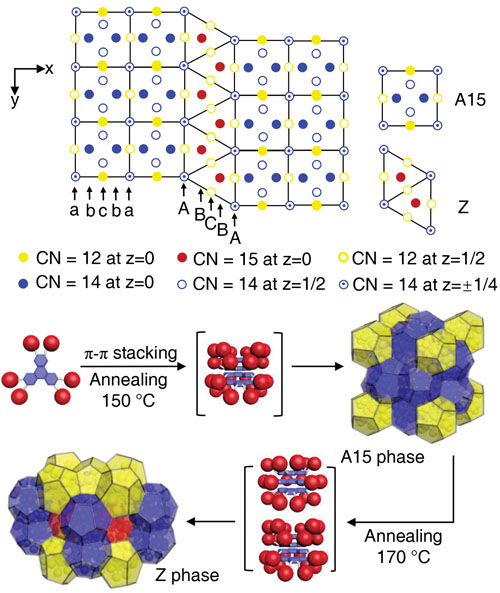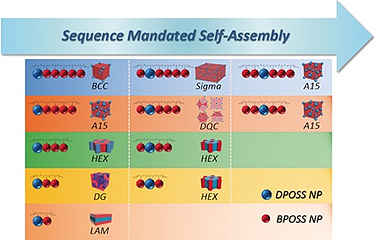12-ID-E is a high-resolution SAXS beamline with two instruments; USAXS and 10m long SAXS. The USAXS instrument runs USAXS, SAXS, and WAXS from ~1E-5 to ~10 inverse angstrom. With the pin-hole SAXS instrument, applicable are various SAXS techniques including simultaneous SAXS and WAXS, coherent SAXS, and micro-focus SAXS. Energy range of 8-35keV Beamline Controls use Linux workstations running SPEC, EPICS applications and SAXS analysis. Link to 12-ID-E Beamline Specifications Link to 12-ID-E USAXS Webpage |
Why Z Phase Matters (December 2019) Deep down on the inside, at the level of atoms, most solid pieces of matter are crystalline. Pure metals like iron often have simple crystal structures, while others can be more complex. Some are even quasicrystals, which have their atoms in complicated, crystal-like patterns that never quite repeat. Studies of the structure of crystalline materials show that many factors influence that atomic geometry, but the size and shape of an atom or molecule is the most important. And that can help solve real-world problems. Famously, British engineer Lord Kelvin in 1887 asked how space could be most efficiently partitioned into cells of equal volume with the least area of surface between them. Kelvin’s problem has never been definitively solved, but in 1994 mathematicians demonstrated that a crystal structure, the Frank Kasper A15 phase, was more efficient than any previous solution. Frank Kasper structures are ordered approximations of quasicrystals. The A15 phase was the inspiration for the Beijing National Aquatics Center water cube for the 2008 Olympics because it allowed for the construction of a space with cells of equal volume using the least amount of material. Another Frank Kasper structure, the Z phase, could theoretically construct the same space with even less material—if the cells are allowed to be unequal. Now, a team of scientists has used the U.S. Department of Energy’s Advanced Photon Source (APS) to show that the Z phase can exist in a soft, self-assembling material. Their work provides insight into potential special properties of Z phase matter, and shows how other, more complex Frank Kasper phases could be constructed. Fig. 1. The mechanism of phase transformation. Starting at top, first the silesquioxane (red) cages attach to the triphenylene core (blue). Then those units fit together to form a Frank Kasper A15 structure. In the structure they squish into polyhedra with either 12 faces (yellow) or 14 faces (blue). After annealing, some of the polyhedra squish even more to have 15 faces (red). This is the Frank Kasper Z phase. From Z. Su et al., Nat. Chem. 11, 899 (October 2019). © 2019 Springer Nature Limited
Giant Molecules as a Unique Platform for Unconventional Nanostructures (June 2018) The engineering of materials into ordered structures is always a critical step to transfer and amplify microscopic molecular functionalities to macroscopic material properties. Tremendous efforts have been made to study the relationship between molecules and the corresponding supramolecular structures as the base for further study of structure-property relationship. Giant molecules are a family of macromolecules with well-defined three-dimension structures built up from molecular nanoparticles with precise chemical structures. They  typically include folded globular proteins, polyhedral oligomeric silsesquioxane (POSS), fullerene (C60), and polyoxometalates (POMs). A multitude of studies have demonstrated that they are a unique and efficient platform upon which to construct various ordered patterns in a desired feature size. Recently, researchers using the U.S. Department of Energy’s Advanced Photon Source (APS) have shown that altering the composition and sequence of giant molecules answers some fundamental questions about how giant molecules can be used for the assembly of controllable, well-defined, self-assembled nanostructures. typically include folded globular proteins, polyhedral oligomeric silsesquioxane (POSS), fullerene (C60), and polyoxometalates (POMs). A multitude of studies have demonstrated that they are a unique and efficient platform upon which to construct various ordered patterns in a desired feature size. Recently, researchers using the U.S. Department of Energy’s Advanced Photon Source (APS) have shown that altering the composition and sequence of giant molecules answers some fundamental questions about how giant molecules can be used for the assembly of controllable, well-defined, self-assembled nanostructures. Besides the composition factor, sequence controlled giant molecules were also designed and studied. A series of sequence controlled chain-like giant molecules based on one hydrophilic DPOSS and multiple hydrophobic BPOSS nanoparticles were synthesized. As shown in Fig. 2, besides the compositional variation (shown in the vertical direction of the table), the sequence of the giant molecule chain also plays an important role in the supramolecular phase formation process (shown in the horizontal direction of the table), resulting in versatile
|


 typically include folded globular proteins, polyhedral oligomeric silsesquioxane (POSS), fullerene (C60), and polyoxometalates (POMs). A multitude of studies have demonstrated that they are a unique and efficient platform upon which to construct various ordered patterns in a desired feature size. Recently, researchers using the U.S. Department of Energy’s Advanced Photon Source (APS) have shown that altering the composition and sequence of giant molecules answers some fundamental questions about how giant molecules can be used for the assembly of controllable, well-defined, self-assembled nanostructures.
typically include folded globular proteins, polyhedral oligomeric silsesquioxane (POSS), fullerene (C60), and polyoxometalates (POMs). A multitude of studies have demonstrated that they are a unique and efficient platform upon which to construct various ordered patterns in a desired feature size. Recently, researchers using the U.S. Department of Energy’s Advanced Photon Source (APS) have shown that altering the composition and sequence of giant molecules answers some fundamental questions about how giant molecules can be used for the assembly of controllable, well-defined, self-assembled nanostructures.